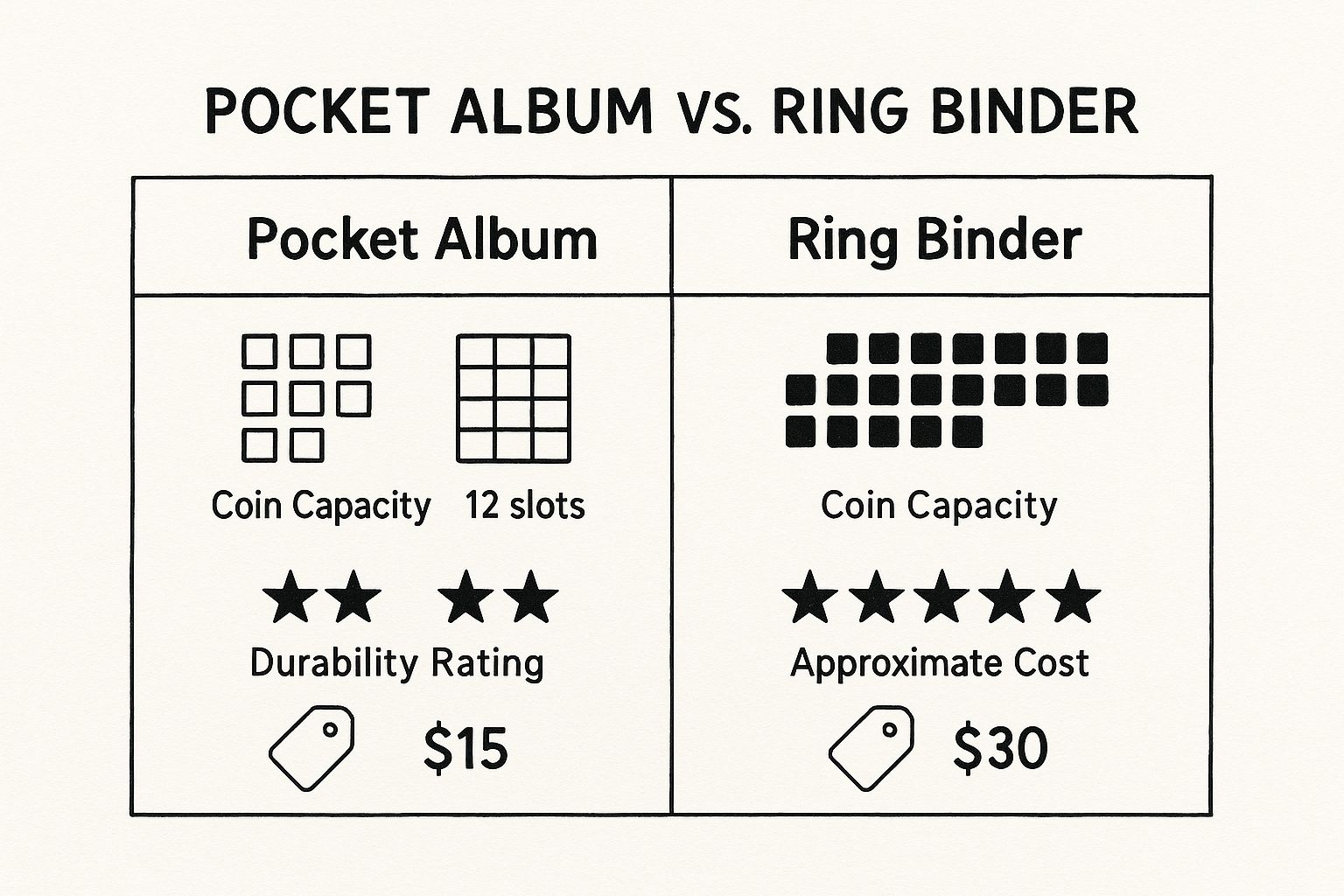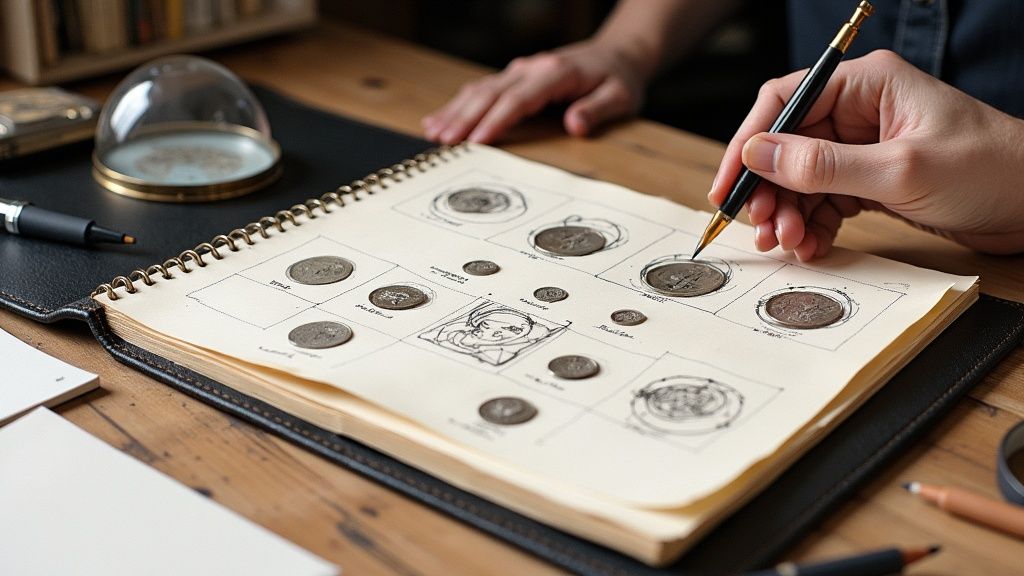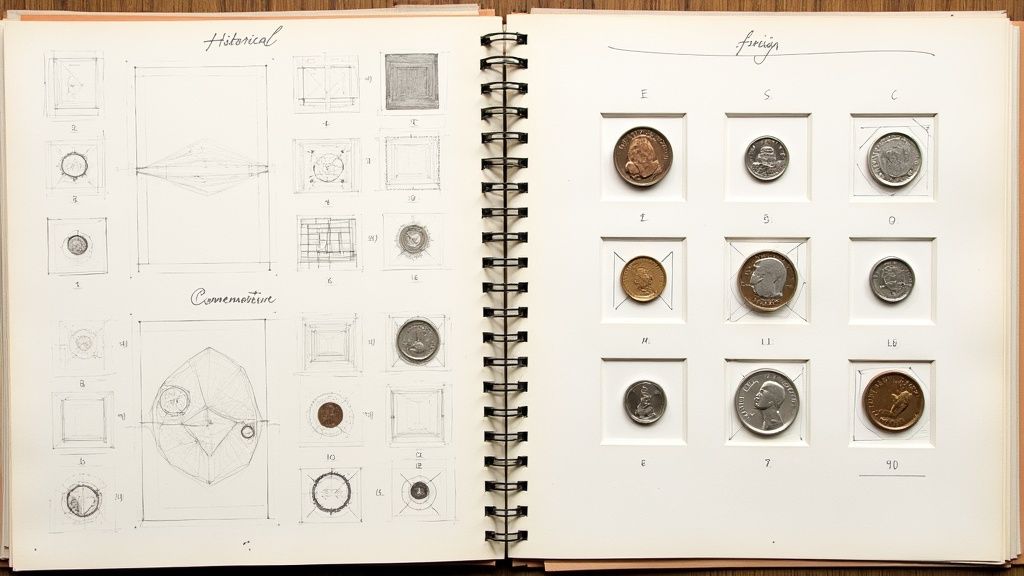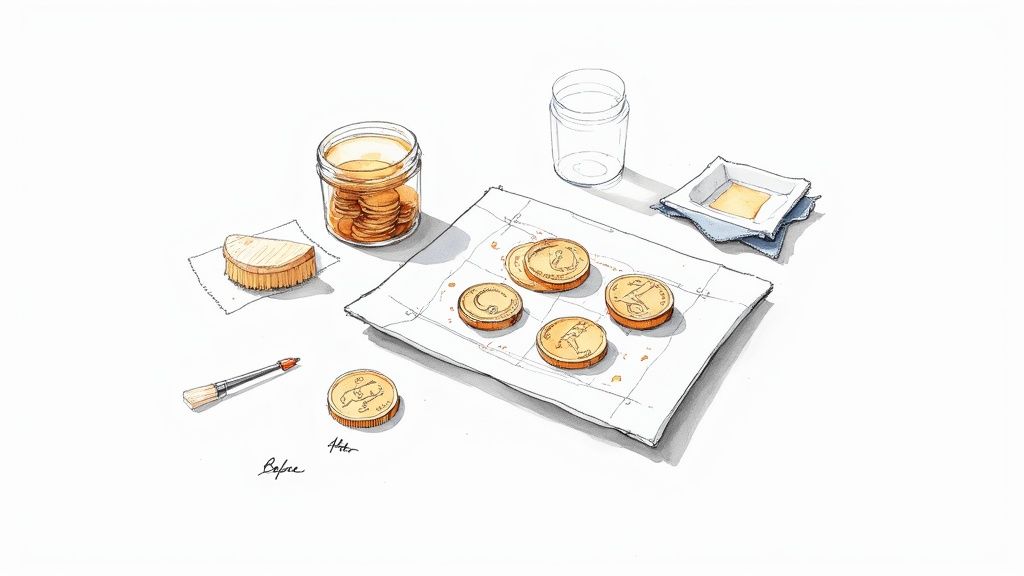Choosing the right album is probably the single biggest decision you'll make for your album coins collection. It's what separates simple storage from genuine, long-term preservation. A good album doesn't just hold your coins; it safeguards them from damage and turns your hobby into a beautifully displayed legacy.
Finding the Perfect Home for Your Coins
Most of us start our coin collecting journey with just one fascinating piece, but that spark can quickly grow into a treasured assortment. Giving these treasures the right home is absolutely crucial.
If you're just starting out, a simple Whitman folder is a great, budget-friendly way to organise common circulation coins. They let you see your progress at a glance as you fill the slots. But as your collection starts to include more valuable pieces, you'll need to think about stepping up your protection.
Time to Get Serious: Archival-Quality Albums
For the more serious numismatist, graduating to an archival-quality album is a natural next step. These albums are built for preservation, not just display. The most important thing to check is the material.
Always, always choose albums with pages made from PVC-free plastics like Mylar. Over time, plastics containing PVC can degrade and release nasty chemicals, leaving a green, sticky residue that can permanently ruin a coin's surface.
A Look at Popular Album Brands
When you start exploring higher-end options, two names will pop up again and again: Whitman and Dansco.
Whitman's Classic Coin Albums are a solid and reliable choice, striking a great balance between quality and affordability. They give you a structured way to store and show off valuable pieces. Think about something like the sought-after 2009 Kew Gardens 50p – with a tiny mintage of just 210,000, these can sell for over £150. A coin like that demands proper protection.
Many collectors consider Dansco Supreme Coin Albums to be the premium choice, and for good reason. They're known for their exceptional durability and elegant design. While they do come with a higher price tag, their solid construction offers robust protection against environmental damage. For a deeper dive into other fantastic options, check out our guide on the top coin collecting albums for 2025.
Coin Album Type Comparison
To help you visualise the options, here's a quick comparison of the most common types of coin albums. This should make it easier to decide which style is the best fit for your collection.
| Album Type | Best For | Pros | Cons |
|---|---|---|---|
| Folders (e.g., Whitman) | Beginners, circulation coins, kids' collections. | Very affordable, easy to see what you're missing. | Minimal protection, only one side of the coin is visible. |
| Ring Binders (2x2s) | Custom collections, storing graded slabs. | Highly flexible and expandable, can mix and match pages. | Can be bulky, requires buying pages and holders separately. |
| Push-in Albums (e.g., Dansco) | Serious collectors building a specific set (e.g., UK 50p coins). | Both sides of the coin are visible, excellent protection. | More expensive, less flexible than binders. |
Ultimately, the best album depends on your goals and your budget. Whether you're filling a simple folder or investing in a premium Dansco, giving your coins a proper home is a key part of the hobby.

As you can see, something like a ring binder offers a big jump in capacity and durability for a relatively small increase in price, making it a smart long-term investment for a growing collection.
How to Organise Your Coin Collection

Once you've found the perfect album, the real fun begins: filling it up. A thoughtfully organised album coins collection is not just more satisfying to look through; it's also far easier to manage and value. The strategy you land on will depend entirely on what you want to achieve with your collection.
A classic approach, and where many collectors start, is arranging coins chronologically by their date and denomination. This method works beautifully for definitive sets, like lining up every UK penny from a specific monarch's reign. It gives you a crystal-clear visual timeline of your progress.
Exploring Thematic Collections
If you're looking for a more creative angle, you could organise your collection thematically. This approach adds a narrative layer, essentially turning your album into a story you can share.
You could try focusing on themes like:
- Royal Events: Dedicate pages to coins issued for coronations, jubilees, or royal weddings.
- Historical Periods: Group coins from significant eras, such as the Victorian period or the Second World War.
- Design Focus: Collect coins that feature specific animals, famous ships, or architectural landmarks.
This method really lets you inject your own personality and creativity into your collection.
Before you place a single coin, remember the golden rule of handling: always use clean, soft cotton gloves. The natural oils and acids on your fingertips can cause permanent fingerprints and corrosion, irreversibly damaging a coin's surface.
The Importance of Cataloguing
As your collection grows, keeping a detailed inventory becomes absolutely essential. Think of this catalogue as your collection’s brain, tracking all the vital information that the album itself can't show. It’s where you’ll record acquisition dates, purchase costs, and the specific condition or grade of each coin. For a deeper look, check out our complete guide on how to catalogue coins effectively.
This kind of detailed record-keeping is more important than ever as the numismatic market expands. In fact, the global coin collecting market is projected to see a compound annual growth rate of around 10.5% between 2025 and 2032. This trend highlights the growing interest and potential value in rare pieces. Proper cataloguing ensures you have a precise, up-to-date understanding of your collection's true worth.
Mastering Long-Term Coin Preservation

A coin album is much more than just a way to organise your collection; it's the first line of defence for your prized pieces. Over time, your coins face a number of environmental threats that can cause irreversible damage, hitting both their beauty and their value. Getting to grips with these dangers is the first step to mastering long-term preservation.
The biggest enemies of any coin are humidity, extreme temperatures, and direct light. A damp cellar or a sun-baked loft is a coin's worst nightmare. High humidity speeds up oxidation, which can lead to ugly toning or even destructive corrosion, especially on copper and silver coins. Ideally, you want to keep humidity levels consistently low—preferably under 30%.
Creating the Ideal Storage Environment
The best spot for your album coins collection is somewhere cool, dark, and dry. Think of a study, a secure cupboard in a main living area, or even a fire-retardant safe. These places tend to have far more stable conditions than basements, garages, or lofts, which often suffer from dramatic seasonal swings in temperature and moisture.
A few simple tools can make a huge difference in managing your storage climate:
- Silica Gel Packs: Pop a few of these inside your storage box or safe to soak up any excess moisture in the air.
- Hygrometer: This small device measures humidity, giving you real data so you can make adjustments when needed.
Remember, consistency is just as vital as the conditions themselves. Fluctuating temperatures cause metals to expand and contract, which can stress a coin's surface over many years. A stable environment is a safe environment.
Careful Handling Prevents Costly Mistakes
Even with the perfect environment, the wrong touch can cause immediate damage. The natural oils and acids on your skin are corrosive, and a single fingerprint can become permanently etched onto a coin's surface. Always handle your coins by their edges and always wear soft, clean cotton gloves. It’s a simple rule, but one of the most important.
When you're placing coins into an album, be gentle. Never force a coin into a tight slot, as this can easily cause scratches or even damage the holder itself. Take your time, making sure each coin is secure without applying too much pressure. For more detailed advice, exploring the best way to store coins offers further professional insights.
By combining a stable environment with careful handling, you'll ensure your collection stays in pristine condition for generations to come.
Growing Your Collection Strategically
Building a truly impressive collection is a marathon, not a sprint. What separates a random jumble of coins from a cohesive and valuable album coins collection is a smart acquisition strategy. And that all starts with focus.
Decide on a theme or series that genuinely gets you excited. Maybe you want to complete a set of UK decimal coins, or perhaps you're drawn to the history of Victorian-era pennies. Having a clear goal stops you from making impulse buys and gives your search a real sense of purpose. It also makes your collection far more compelling to look at.
Sourcing and Evaluating New Coins
Once you have a goal, you can start the fun part: hunting for new pieces. Using reputable sources is absolutely essential for building a quality collection and, crucially, for avoiding expensive mistakes.
Your best bets for finding quality coins will be:
- Reputable Coin Dealers: Look for professionals who are members of organisations like the British Numismatic Trade Association (BNTA). This is a good sign you're dealing with someone knowledgeable and trustworthy.
- Coin Fairs and Shows: These events are fantastic. You get to see a huge variety of coins up close and personal, and you can chat directly with the sellers.
- Trusted Online Auctions: The internet can be a treasure trove, but you have to be careful. Always, always check a seller's ratings and return policies before you even think about placing a bid.
As you browse, you'll need to get a basic handle on coin grading. Grading is simply the process of determining a coin's physical condition, which has a massive impact on its value. You don't need to become an expert overnight, but learning to tell the difference between a heavily worn, circulated coin and one in crisp "Uncirculated" condition is a fundamental skill for any collector.
A huge part of growing your collection is knowing what not to buy. Learning to spot obvious fakes or heavily damaged coins will save you a lot of money and heartache down the line. Keep an eye out for mushy-looking details, incorrect weight, or tell-tale seams along the edge.
Finally, be realistic about your budget. Figure out how much you can comfortably set aside for your hobby each month or quarter. A clear budget helps you prioritise those key "must-have" coins and ensures your collecting journey stays fun and financially sustainable.
Common Coin Collecting Mistakes to Avoid

We've all been there. Every collector, at some point, makes a misstep. But learning from the most common errors early on can save you a world of heartache and protect the future of your album coins collection. It’s all about building smarter habits from day one.
One of the biggest, and most damaging, mistakes is improper cleaning. That urge to make an old, tarnished coin gleam can be overwhelming, but please, resist it. Using abrasive cleaners or chemicals doesn't just make it shiny; it strips away the coin's natural patina.
That patina is a crucial part of the coin's history, and experienced collectors prize original, untouched surfaces. Aggressive cleaning leaves a web of micro-scratches, permanently tanking a coin's grade and, with it, its market value.
Handling and Housing Errors
Next on the list is how you handle your coins. Touching a coin's face with your bare hands is a cardinal sin in numismatics. The oils and acids from your skin transfer instantly, leading to permanent fingerprints and corrosion over time. The rule is simple: always hold coins by their edges, and if you can, wear a pair of soft cotton gloves.
Choosing the wrong storage materials is just as bad. Using albums with pages made from PVC is a recipe for absolute disaster.
Over time, PVC degrades and leeches a green, sticky residue that can permanently etch its way into a coin's surface. Always, always make sure your albums and holders are made from archival-safe, inert materials like Mylar. This damage is irreversible.
Finally, so many collectors get caught up in the thrill of the hunt that they forget to document or insure their collection. Without a detailed inventory, you simply won't know the true value of what you've got. As a collection grows, it can become a significant investment. Not insuring it against loss or theft is a risky oversight that could have devastating consequences.
Steering clear of these common pitfalls will ensure your collection remains a source of pride and value for many years to come.
Frequently Asked Questions
Even the most experienced collectors run into questions now and again, particularly when it comes to the nitty-gritty of protecting and valuing their coins. Getting straight answers to these common queries will help you build your album coins collection with far more confidence.
What’s the Best Way to Clean Coins Before Putting Them in an Album?
The golden rule in numismatics couldn't be simpler: don't clean your coins. It's a tempting thought, but using chemicals or even just an abrasive cloth will strip a coin of its natural patina. That patina is a huge part of its history and appeal.
Worse still, any cleaning almost always creates countless tiny scratches, which can absolutely destroy its collectible value.
If a coin has some loose dirt or grime on it, the most you should ever do is give it a gentle rinse in distilled water. Afterwards, just pat it dry with a soft, lint-free cloth. Any kind of rubbing, polishing, or scrubbing is one of the biggest mistakes a collector can make.
How Do I Know if My Coin Collection Is Valuable?
A coin's value really comes down to three things: its rarity, its condition (what we call its 'grade'), and the current market demand. A fantastic starting point for any UK collector is to look up your coins in a trusted price guide, like the Spink 'Coins of England' catalogue.
For any coins you suspect might be highly valuable, the safest route is to seek a professional appraisal. A member of the British Numismatic Trade Association (BNTA) can provide an expert and accurate assessment.
Are PVC Coin Album Pages Really That Bad?
Yes, they're a genuine menace to your collection. PVC, or polyvinyl chloride, is incredibly damaging to coins over the long term. The material contains plasticisers that break down over time, releasing an oily residue and acidic fumes.
This process leads to what collectors call "PVC damage" – a green, sticky film that can permanently etch and ruin a coin's surface. It's not a pretty sight.
To keep your collection safe, always double-check that your albums and pages are made from inert, archival-quality materials. Look for plastics like Mylar or polyethylene. Your coins' long-term preservation truly depends on it.
Ready to house your collection in albums that offer premium, archival-safe protection? Explore the curated selection at Cavalier Coins Ltd and find the perfect home for your treasures. Visit us at https://www.cavaliercoins.com to browse our full range.

